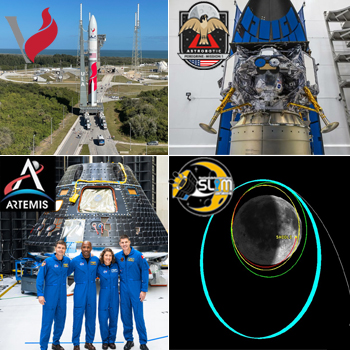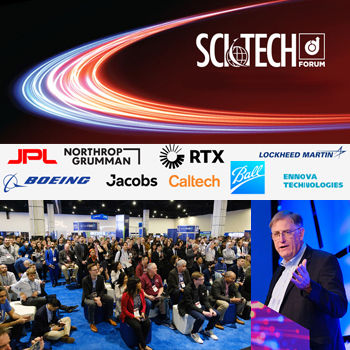Astrobotic Set for Launch to Moon, First of Many Planned for 2024
|
MONDAY☆ Jan 8 — International Space Station, ~415-km LEO: Expedition 70 seven-member crew working with 3D bioprinting, protein crystals, combustion and fire safety experiments, and preparing to receive 4 visitors for Axiom Mission 3 next week. ☆ Jan 8 — Tiangong Space Station, ~390-km LEO: CMSA continues analysis of Tianhe core module solar panels after micrometeorite damage prompted necessary EVA for repair work by Shenzhou-17 crew. Highlights… o NewSpace: Rocket Lab to build 18 spacecraft for USA government under $489M deal with launches starting NET 2027; Space Epoch of China raises $28M for development of ‘mini-starship’ XZY-1 rocket, plans sea recovery test this year; Axelspace of Toyko to expand Earth observation constellation and AxelLiner smallsat construction business unit with $44M funding. ☆ Solar System: Juno 1,497-km flyby of Io during 57th Jupiter orbit produces spectacular images being viewed globally; Venus Life Finder PI Sara Seager and son Max investigating possibility of life which utilizes sulfuric acid as solvent ahead of NET Jan 2025 mission; Planetary scientists working to understand nature of polygon structures discovered via Zhurong ground-penetrating radar under Utopia Planitia on Mars. ☆ Galaxy: Studies published in Nature Astronomy call for recognition of exoplanet oxygen abundance as technosignature and lack of carbon dioxide as biomarker; Scintillation arc observed within FRB by FAST may be caused by ions in interstellar medium; Estonia study of NANOGrav data raises possibility that low-frequency gravitational waves in MWG could emanate from primordial cosmic sources rather than merging SMBHs; India XPoSat in LEO to begin check outs before observing bright astronomical X-ray sources. o Global: ESA and CNES aim to cut carbon emissions 3000t / yr at Guyana Spaceport through $45M investment in Project Hyguane electrolysis hydrogen plant; CASC, Norinco Group and CASIC leaders are to vacate positions on Chinese People’s Political Consultative Conference; Commemorative AU$1 coin with theme Out of this World – Australia in Space celebrating national space legacy issued by Royal Australian Mint. ● USA: Blue Origin, Textron and Cerberus compete to purchase establishment space company United Launch Alliance; Republican politicians decry Artemis goal of landing woman and person of color on Moon while SpaceX CEO condemns Diversity, Equity and Inclusion as ‘immoral’; Rotating Detonation Rocket Engine (RDRE) at Marshall Space Flight Center achieves 25,810 newtons of thrust for 251 seconds. ● Hawai’i: Luminous Fast Blue Optical Transient dubbed ‘Tasmanian Devil’ characterized by global telescopes including Keck may be new object class; Privateer intern Kealia Sjostrand reflects on opportunity to work on Pono-1 mission via Pacific Intelligence and Innovation Initiative (P3I); West Hawaii Today features upcoming 2024 lunar landing missions, including Intuitive Machines carrying ILO-X astronomy instruments. |
 |
● = Terrestrial and… o = International terrestrial events
☾ = Moon activity ★ = Space and… ☆ = International space / astro events in Hawaii Standard Time unless noted. Add 10 hours to obtain UT (‘Universal Time’). |
Weekly Planet Watch – Evening Planets: Jupiter (S), Saturn (SW), Uranus (SW), Neptune (S); Morning Planets: Mercury (S), Mars (E), Venus (SE).
AIAA Opens New Year 2024 with 5,000+ at SciTech Forum in Orlando
|
★ Jan 8 — ULA, Launch Vulcan Centaur / Astrobotic Peregrine Lander, SLC-41, Cape Canaveral SFS FL: Inaugural launch of Vulcan Centaur carrying Astrobotic Peregrine lander for Moon touchdown near Gruithuisen Domes, with 5 NASA payloads for Artemis Program, CMU Iris Lunar Rover, total 90 kgs of customer payloads from commercial companies and international space agencies, institutions; 02:18 EST. ☆ Jan 8 — CAS Space, Launch Long March 2C / Einstein Probe, Xichang Satellite Launch Center, China: Astronomy probe to launch on Long March 2C rocket. o Jan 8-12 — ETH Zurich, NCCR PlanetS, Swiss National Science Foundation, et al, Zurich, Switzerland and Online: Rocky Worlds III. ● Jan 8-14 — American Institute of Aeronautics and Astronautics, Orlando FL: 2024 AIAA Science and Technology Forum and Exposition (AIAA SciTech Forum). ☾ Jan 8 — Moon: 0.86° NE of Antares, 06:00; 5.6° S of Venus, 09:00. ☆ Jan 8 — Aten Asteroid 2002 AY1: Near-Earth Flyby (0.038 AU) Ongoing… ☾ Sep 6 – NET Jan 20 — Smart Lander for Investigating Moon (SLIM), Lunar Landing Trajectory: SLIM Moon mission 4-6 month trajectory to soft land east of Shioli crater (13.2°S, 25.2°E) on Moon near side equatorial region. ☆ Sep 6 – NET Mar — X-Ray Imaging and Spectroscopy Mission (XRISM), ~550-km LEO: XRISM undergoing 6 month check out testing phase before start of science operations to study galactic plasma. ● Jan 7-11 — American Astronomical Society, New Orleans LA: 243rd Meeting of the AAS; at New Orleans Morial Convention Center. ● Sep – Feb 15 — Institute for Scientist & Engineer Educators at University of California Observatories, University of Hawaiʻi, Online: Akamai Internship Program; accepting applications from STEM undergrads for 2024 session. TUESDAY☆ Jan 9 — CAS Space, Launch Kinetica-1 / Payload TBC, Jiuquan Satellite Launch Center, China: Commercial CAS Space to launch its third Kinetica-1 rocket (Y3) with unconfirmed payload. ● Jan 9 — NASA, Online / Washington DC: Phase 1 Solicitations for Small Business Innovation Research & Small Business Technology Transfer (SBIR/STTR) Program to be released. ☾ Jan 9 — Moon: 6.6° S of Mercury, 09:00; 4.2° S of Mars, 23:00. ☆ Jan 9 — Apollo Asteroid 2023 XN13: Near-Earth Flyby (0.040 AU) |
WEDNESDAY
☆ Jan 10 — JAXA, Launch H2A / IGS-Optical 8, Tanegashima Space Center, Japan: H2A rocket to launch IGS-Optical 8 (Intelligence Gathering Satellite) for Japan to SSO.
o Jan 10 — Physical Research Laboratory (PRL), Ahmedabad, India: Abstracts Due: International Conference on Planets, Exoplanets, and Habitability (ICPEH); being held Feb 5-9.
☆ Jan 10 — Apollo Asteroid 2023 YO1: Near-Earth Flyby (0.017 AU)
THURSDAY
● Jan 11-12 — Kitt Peak National Observatory, Tucson AZ: Overnight Telescope Observing Program; visitors use one of four Visitor Center telescopes.
☾ Jan 11 — Moon: New Moon, 01:57.
☆ Jan 11 — Apollo Asteroid 2023 WZ3: Near-Earth Flyby (0.041 AU)
FRIDAY
o Jan 12 — Royal Astronomical Society, London, United Kingdom: 204th Observation of RAS founding (1820).
● Jan 12 — The Space Show, Online / Las Vegas NV: Dr. David Livingston hosts Bob Werb, cofounder of Space Frontier Foundation.
● Jan 12-14 — National Space Society, Kennedy Space Center FL: NSS Members Only Exclusive Tour of the Kennedy Space Center; including KSC, VAB, LC-39 Gantry, LCs 39A & 39B, Apollo/Saturn Center, and Cape Canaveral SFS (Hangar C and Complex 26 Blockhouse).
☆ Jan 12 — Aten Asteroid 2017 UN1: Near-Earth Flyby (0.071 AU)
SATURDAY
☾ Jan 13 — Moon: At perigee (362,279 km), 00:39.
☆ Jan 13 — Apollo Asteroid 2021 VB2: Near-Earth Flyby (0.078 AU)
SUNDAY
☾ Jan 14 — Moon: 1.96° SE of Saturn, 02:00.

